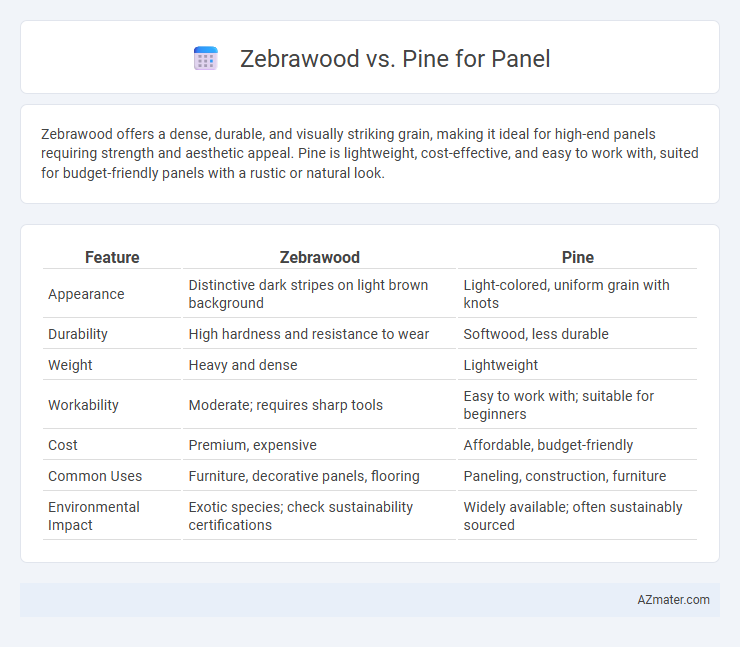Zebrawood offers a dense, durable, and visually striking grain, making it ideal for high-end panels requiring strength and aesthetic appeal. Pine is lightweight, cost-effective, and easy to work with, suited for budget-friendly panels with a rustic or natural look.
Table of Comparison
| Feature | Zebrawood | Pine |
|---|---|---|
| Appearance | Distinctive dark stripes on light brown background | Light-colored, uniform grain with knots |
| Durability | High hardness and resistance to wear | Softwood, less durable |
| Weight | Heavy and dense | Lightweight |
| Workability | Moderate; requires sharp tools | Easy to work with; suitable for beginners |
| Cost | Premium, expensive | Affordable, budget-friendly |
| Common Uses | Furniture, decorative panels, flooring | Paneling, construction, furniture |
| Environmental Impact | Exotic species; check sustainability certifications | Widely available; often sustainably sourced |
Introduction to Zebrawood and Pine Panels
Zebrawood panels, known for their distinctive dark stripes on a light brown background, offer exceptional durability and a unique aesthetic ideal for high-end furniture and decorative applications. Pine panels feature a softwood grain with a light yellow tone, prized for its affordability, ease of workability, and versatility in construction and interior paneling. Both materials serve different design needs, with Zebrawood providing exotic appeal and Pine delivering practical, cost-effective solutions for paneling projects.
Origin and Characteristics of Zebrawood
Zebrawood, primarily harvested from Central and West Africa, is renowned for its bold, dark brown stripes contrasting with a light golden-yellow background, lending panels a striking, exotic appearance. It is dense, durable, and moderately oily, offering excellent stability and resistance to wear, making it suitable for high-quality interior paneling compared to the softer, lighter pine sourced mainly from North America and Europe. The distinctive grain of zebrawood adds unique aesthetic value and durability to panels, while pine provides a more affordable and easily workable alternative with a pale, uniform texture.
Key Features of Pine Wood Panels
Pine wood panels exhibit a lightweight structure with consistent grain patterns and excellent workability, making them ideal for interior paneling and furniture. Their natural softness allows for easy cutting, shaping, and finishing, contributing to cost-effective and versatile applications. Pine's high resin content enhances durability and resistance to wear while providing a warm, rustic aesthetic that contrasts with the denser, more exotic zebrawood.
Appearance Comparison: Grain, Color, and Texture
Zebrawood features striking, bold grain patterns with dark brown to black streaks contrasted against a lighter golden or creamy background, creating a visually dynamic panel surface. Pine, in comparison, displays a softer, more uniform grain with subtle knots and a pale cream to light yellow hue, offering a warm and understated appearance. Zebrawood's coarse texture adds a tactile richness, whereas pine's smoother texture provides a more refined and consistent finish ideal for various interior panel applications.
Durability and Hardness: Zebrawood vs Pine
Zebrawood exhibits significantly higher durability and hardness compared to pine, with a Janka hardness rating of approximately 1,380 lbf versus pine's range of 380 to 870 lbf depending on the species. This makes zebrawood more resistant to dents, scratches, and wear, ideal for panels in high-traffic or heavy-use areas. Pine's softer nature, while easier to work with and shape, results in lower durability, making it better suited for decorative or low-impact panel applications.
Workability and Ease of Installation
Zebrawood offers excellent workability due to its stability and smooth finish, making it ideal for precision paneling projects, but it can be challenging to cut because of its interlocking grain. Pine is easier to work with, thanks to its softness and straight grain, allowing for quick cutting, sanding, and installation, making it a favorite for DIY paneling. Pine panels are more forgiving during installation, while Zebrawood requires more experienced handling to avoid splintering and ensure a clean, professional finish.
Cost Analysis: Zebrawood vs Pine Panels
Zebrawood panels are significantly more expensive than pine due to their exotic nature and limited availability, with prices ranging from $15 to $30 per square foot compared to pine's $3 to $6 per square foot. Pine panels offer greater affordability and easier sourcing, making them a cost-effective choice for large-scale or budget-conscious projects. The higher cost of zebrawood reflects its dense grain, durability, and aesthetic appeal, which may justify the investment for premium applications.
Environmental Impact and Sustainability
Zebrawood, sourced primarily from West African trees like Microberlinia brazzavillensis, is a dense hardwood known for its durability and distinctive striped grain, but its harvesting poses significant environmental risks due to slow growth rates and limited reforestation efforts, contributing to habitat loss and deforestation. Pine, commonly derived from fast-growing species such as Pinus sylvestris or Pinus radiata, offers a more sustainable option with its rapid renewability, effective plantation management, and lower carbon footprint in production, making it preferable for eco-conscious paneling projects. Lifecycle assessments show pine panels often result in fewer greenhouse gas emissions and promote biodiversity preservation, aligning better with sustainable forestry certifications like FSC and PEFC compared to zebrawood.
Maintenance and Longevity
Zebrawood panels are highly durable and resistant to wear, requiring minimal maintenance such as occasional dusting and polishing to preserve their distinctive grain patterns. Pine panels, while more affordable, are softer and prone to dents and scratches, demanding regular sealing and refinishing to maintain their appearance and protect against moisture damage. Over time, Zebrawood offers superior longevity due to its hardness and natural resistance to decay, making it a more cost-effective choice for long-term panel installations.
Best Applications: Choosing the Right Wood for Your Project
Zebrawood features a striking striped grain and high durability, making it ideal for decorative paneling, luxury furniture, and accent walls where aesthetics are paramount. Pine offers a softer texture and affordability, suitable for interior panels, cabinetry, and DIY projects requiring ease of workability and a lighter appearance. Selecting between Zebrawood and Pine depends on your project's need for visual impact, strength, and budget constraints.

Infographic: Zebrawood vs Pine for Panel
 azmater.com
azmater.com